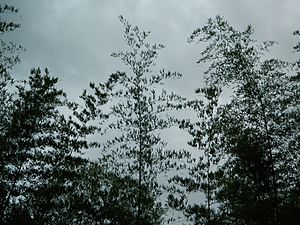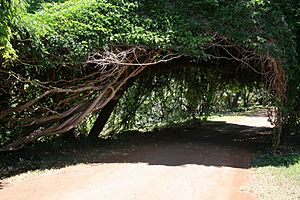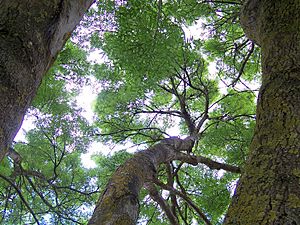Canopy facts for kids
In the world of biology, a canopy is like the roof of a group of plants or a farm field. It's made up of all the tops of individual plants or trees, called their "crowns," when they grow together.
When we talk about forest ecology (which is how forests work), the canopy is the very top layer of the forest. It's formed by the crowns of tall, grown-up trees. This layer is also home to many other living things. You might find epiphytes (plants that grow on other plants, like some mosses or orchids) and lianas (long, woody vines). Many animals that live in trees also call the canopy their home.
Sometimes, the word "canopy" can also mean just the outer layer of leaves on a single tree or a small group of trees. For example, a Shade tree usually has a very thick canopy. This thick layer blocks a lot of sunlight from reaching smaller plants growing below it.
What is Canopy Structure?
Canopy structure is simply how the plants in a canopy are arranged. Think of it as the shape and layout of the plant "roof." Scientists often measure something called the "Leaf Area Index" (LAI). This helps them understand how much leaf surface there is compared to the ground area below. It's a way to compare different canopies. The canopy layer is always taller than the understory layer, which is the layer of smaller plants and shrubs below the canopy.
The Forest Canopy Layer
The canopy layer in a forest is usually made up of the tallest trees. These trees are called "dominant" or "co-dominant" because they stand out. The canopy isn't perfectly flat; it's often uneven, with some trees taller than others.
Trees in the canopy get lots of sunlight. This means they can photosynthesize (make their own food from sunlight) very quickly. Because of this, the canopy is where most of the forest's energy is produced. It's like the main engine of the forest!
The canopy layer also acts like a shield. It protects the forest from strong winds and storms. It also catches most of the sunlight and rain. This means that the understory layer below the canopy often doesn't get as much light or water, so fewer plants grow there.
Life in the Canopy
Forest canopies are amazing places! They are home to many unique plants and animals that you won't find in other parts of the forest. The highest number of different living things (called biodiversity) on land is found in the canopy of tropical rainforests. Many rainforest animals have even evolved to live their entire lives in the canopy, never needing to touch the ground!
In a rainforest, the canopy is usually about 10 meters (about 33 feet) thick. It can block around 95% of the sunlight from reaching the ground. Above the main canopy, there's an even taller, sparser layer called the emergent layer. This layer has just a few very tall trees, maybe one or two per hectare (a hectare is an area about the size of a soccer field).
Rainforests have plenty of water and warm temperatures, which are great for tree growth. However, light and nutrients can sometimes be limited for trees trying to grow from the understory up to the canopy.





